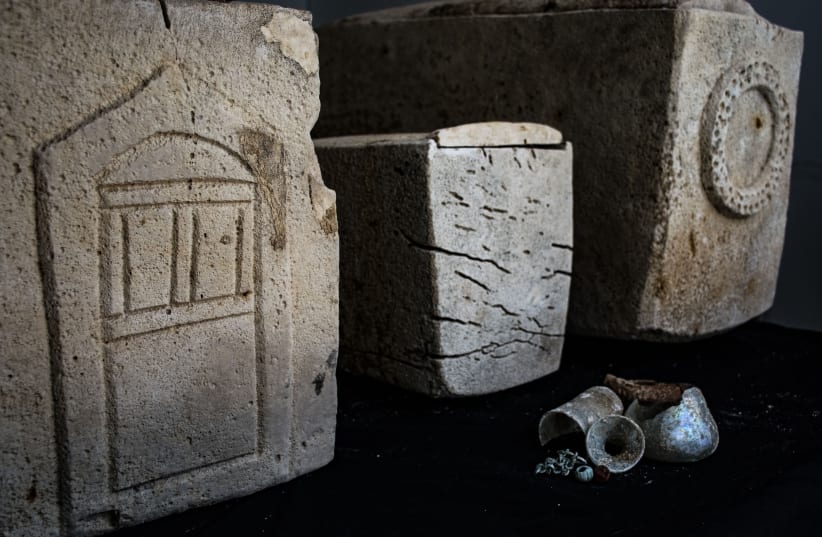In an operation by the Kafr Kanna police and the robbery prevention unit at the Israel Antiquities Authority, a burial cave with unique several decorated stone ossuaries (small coffins) that had been used for the secondary burial of Jews about 1,850 years ago in the days after the Bar Kochba revolt was discovered.
Kanna (in the Mashhad Regional Council) is an Arab town about seven kilometers northeast of Nazareth in the Lower Galilee that is revered by Christians as the site of the New Testament “miracle” they say was performed by Jesus when he turned water into wine.
As part of intelligence activity, policemen and Antiquities Authority inspectors arrived at a private lot in the Mashhad Regional Council. There, to their astonishment, they saw that extensive infrastructure works had been carried out on the spot using heavy engineering tools, while completely destroying an ancient burial cave that stood on the spot. All that remains of the cave was a single burial mound.
How did the police spot the theft?
Inspectors of the authority’s anti-theft unit noticed a number of piles of earth in the area of the lot, which seemed to be hiding something behind them. The owner of the land and responsible for the construction site was asked to remove the piles of dirt, and behind them, an ancient burial cave was discovered, hewn out of the rock, with nine burial mounds in it. To the surprise of the inspectors, at the entrance of the cave were found three decorated stone ossuaries that had used in ancient times to collect human bones. They were empty and not in their natural place, which raised the immediate suspicion that the cave had recently been robbed of antiquities.Video of a burial cave discovered after grave robbers damaged it, north of Nazareth. May 2023. (Credit: Nir Distelfeld/Israel Antiquities Authority's Robbery Prevention Unit)
Construction work at the site was stopped, and several suspects were summoned for questioning at the police station on suspicion of damaging antiquities and failing to report their discovery. At the same time, the authority’s inspectors documented and removed the ancient remains out of concern that of additional thefts from the cave.
According to Dr. Eitan Klein, deputy-director of the Antiquities Authority's robbery prevention unit, “The ossuaries are made of soft limestone and rectangular in shape, and they have flat lids that were adapted to them. The decorated coffins were used by the Jewish population in the Galilee during the 2nd to 3rd centuries CE.
Images related to the Jewish burial world and influenced by Greek culture were carved on the coffins; on top of one of them was a model resembling a mausoleum (burial structure) – sometimes identified as a “nefesh” – a memorial “hand” to mark the deceased). On the other side of the coffin, a circular wreath was carved with holes drilled into it, which probably symbolizes the victory of the deceased over death.
These models are very typical of the stone ossuaries used by the Jewish population in the Galilee in the Middle Roman period. In the past, similar decoration models were discovered on coffins from the burial site.
Archaeologists who research the Land of Israel, accept the fact that stone ossuaries were an exclusive feature of the burial of the Jewish population during the final days of the Second Temple - mainly in the 1st century BCE until the time of the Bar Kochba revolt in the 2nd century CE. Such burial was prevalent during this period in the Jerusalem region, the mountains and the Judean plains, when most of the production of these coffins was carried out in factories that operated in the Jerusalem and plains area. This burial custom became widespread in the Galilee following the failure of the Bar-Kochva rebellion and the arrival of a Jewish population to the region from Judea. Therefore, the finding of decorated stone ossuaries in a cave in Kafr Mashhad points to the existence of a Jewish settlement there.
According to Amir Ganor, director of the robbery-prevention unit at the authority, “in this case, there is a suspicion of serious damage to the antiquities. The diggers completely destroyed an ancient burial cave and were allegedly in the midst of looting another burial cave. We will never know what the destroyed cave looked like or what was inside it and disappeared. Cultural assets almost 2,000 years old were lost forever. Thanks to the vigilance and determined activity of the Kafr Kanna police and successful cooperation with the Antiquities Authority, one of the caves was saved and its archaeological and historical information about the site and the ancient settlement were saved/”
Damaging antiquities is a criminal offense punishable by law with five years in prison, and there is a legal obligation to report to the Antiquities Authority about any accidental finding of any antiquities.
According to Eli Eskozido, director of the Antiquities Authority, “There are some 35,000 antiquities sites in Israel, and each one is a world in its own right, including information on thousands of years of human history. The destruction of the cave in the north caused irreversible damage. I call on the general public to continue to be vigilant and help us by reporting any suspicious activity of excavation, quarrying or construction in places where there is a risk of damage to the antiquities. In this way, the public will serve as our ‘eyes in the field.’ Together, we will be able to protect our national resource – the heritage treasures of the Land of Israel.”
